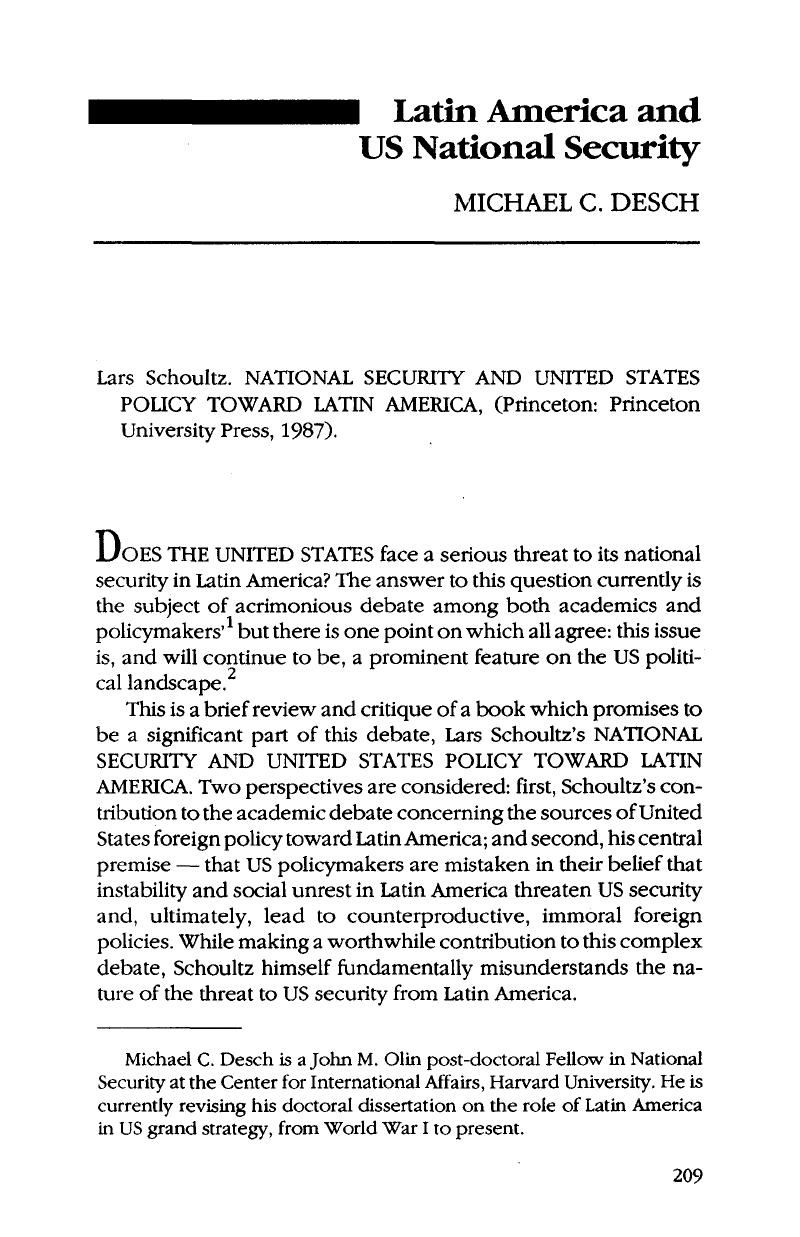No CrossRef data available.
Article contents
Latin America and US National Security
Published online by Cambridge University Press: 02 January 2018
Abstract
An abstract is not available for this content so a preview has been provided. Please use the Get access link above for information on how to access this content.

- Type
- Review Essays
- Information
- Journal of Interamerican Studies and World Affairs , Volume 31 , Issue 4 , Winter 1989 , pp. 209 - 224
- Copyright
- Copyright © University of Miami 1989
References
Bath, R. and James, D. (1976) “Dependency Analysis of Latin America; Some Criticisms, Some Suggestions.” Latin American Research Review
11, 3:14.CrossRefGoogle Scholar
Bodenheimer, S. (1971) “Dependency and Imperialism: The Roots of Latin American Underdevelopment.” Politics and Society
1, 3 (May): 348.CrossRefGoogle Scholar
Bodenheimer, S. (1970) “The Ideology of Developmentalism: American Political Science's Paradigm-Surrogate for Latin American Studies.” Berkeley Journal of Sociology: 128.Google Scholar
Cardoso, F. and Faletto, E. (1979) Dependency and Development in Latin America.
Berkeley, CA: University of California Press.CrossRefGoogle Scholar
Central Intelligence Agency (CIA) (1982) “Annex B: Military Significance of Ballistic Missiles in Cuba” to CIA, “Subject: SNIE 11-18-62: Soviet Reactions to Certain US Courses of Action on Cuba,” pp. 1-2, Reel 3 in CIA Research Reports on Latin America, 1946-1976. Frederick, MD: University Publications of America, Inc.Google Scholar
Conn, S. and Fairchild, B. (1960) The Framework of Hemisphere Defense.
Washington, DC: Office of the Chief of Military History, US Department of the Army.Google Scholar
Desch, M. (1987) “Turning the Caribbean Flank: Sea Lane Vulnerability During a European War.” Survival
29,6 (November/December): 530.CrossRefGoogle Scholar
Dominguez, J. (1978) “Consensus and Divergence: The State of the Literature on Interamerican Relations in the 1970s.” Latin American Research Review
13, 1:100–105.CrossRefGoogle Scholar
Ferguson, Y. (1977) “Through Glasses Darkly: An Assessment of the Various Theoretical Approaches to Interamerican Relations.” Journal of Interamerican Studies and World Affairs
19,1 (February): 3–34.CrossRefGoogle Scholar
Finlayson, J. and Haglund, D. (1987) “What Ever Happened to the Resource War?” Survival
29, 5 (September/October): 403–415.CrossRefGoogle Scholar
Garthoff, R. (1982) “The Meaning of the Missiles.” The Washington Quarterly
5, 4 (Autumn): 79.CrossRefGoogle Scholar
Greene, J. and Scowcroft, B. (1984) Western Interests and US Policy Options in the Caribbean Basin.
Boston, MA: Oelgeschlar, Gunn, and Hain Publishers, Inc.Google Scholar
Grey, C. (1977) “Across the Nuclear Divide — Strategic Studies, Past and Present.” International Security
2,1 (Summer).Google Scholar
Haglund, D. (1982) “Grey Areas’ and Raw Materials: Latin American Resources and International Politics in the Pre-World War II Years.” Inter-American Economic Affairs
36, 3 (Winter): 24.Google Scholar
Haglund, D. (1981-82) “Latin American Oil and the Prospects for Western Hemisphere Self-Sufficiency.” International Journal
37, 1 (Winter): 60–75.Google Scholar
Hahn, W. (ed.) (1987) Central America and the Reagan Doctrine.
Lanham, MD: United States Strategic Institute.Google Scholar
Halperin, M. (1940) “Mexico Shifts Her Foreign Policy.” Foreign Affairs
19, 1 (October): 207–221.CrossRefGoogle Scholar
Horelick, A. (1964) “Cuban Missile Crisis: An Analysis of Soviet Calculations and Behavior.” World Politics XVI, 3 (April): 372.Google Scholar
Howard, M. (1973) “The Relevance of Traditional Strategy.” Foreign Affairs
51, 2 (January): 259–264.CrossRefGoogle Scholar
Kurth, J. (1973) “United States Foreign Policy and Latin American Military Rule,” pp. 249–251 in Schmitter, P.C. (ed.) Military Rule in Latin America.
Beverly Hills, CA: Sage Publications.Google Scholar
Lall, S. (1975) “Is Dependence a Useful Concept in Analyzing Underdevelopment?” World Development
3, 12: 800.Google Scholar
Lenin, V. (1975) Imperialism, The Highest Stage of Capitalism.
Peking, China: Foreign Languages Press.Google Scholar
Leogrande, W. (1982a) “Cuba Policy Recycled.” Foreign Policy
46 (Spring): 105–119.CrossRefGoogle Scholar
Marx, K. and F., Engels (1948) The Communist Manifesto.
New York, NY: International Publishers.Google Scholar
McGwire, M. (1987) Military Objectives in Soviet Foreign Policy.
Washington, DC: The Brookings Institution.Google Scholar
McNamara, R. (1963) “Department of Defense Appropriations for 1964.” US Congress, House Committee on Appropriations. 88th Congress, 1st Session.
Washington, DC: Government Printing Office.Google Scholar
Mearsheimer, J. (1982) “Why the Soviets Can't Win Quickly in Central Europe.” International Security
7, 1 (Summer): 8–9.CrossRefGoogle Scholar
Meyer, M. (1966) “The Mexican-German Conspiracy of 1915.” The Americas
23: 76.CrossRefGoogle Scholar
National Bipartisan Commission on Central America (1984) Report of the National Bipartisan Commission on Central America. Washington, DC: U.S. Government Printing Office (January).Google Scholar
Pope, R. (ed.) (1982) Soviet Views on the Cuban Missile Crisis: Myth and Reality in Foreign Policy Analysis.
Washington, DC: University Press of America, Inc.Google Scholar
Rielly, J. (1987) American Public Opinion and US Foreign Policy 1987.
Chicago, IL: Chicago Council on Foreign Relations.Google Scholar
Rogers, M. (1987) “Countering Coastal Cruise Missiles.” United States Naval Institute Proceedings Vol.
113/9/1015 (September): 50–55.Google Scholar
Rout, L. and Bratzel, J. (1986) The Shadow War: German Espionage and United States Counter-espionage in Latin America During World War II.
Frederick, MD: University Publications of America, Inc.Google Scholar
Rush, K. and Scowcroft, B. (1981) Strengthening Deterrence.
Cambridge, MA: Ballinger Publishing Co.Google Scholar
Sandos, J. (1970) “German Involvement in Northern Mexico 1915- 1916: A New Look at the Colombus Raid.” Hispanic-American Historical Review L, 1 (February): 81–82.Google Scholar
Slater, J. (1987) “Dominoes in Central America: Will They Fall? Does it Matter?” International Security
12, 2 (Fall): 105–134.Google Scholar
Smith, W. (1982) “Dateline Havana: Myopic Diplomacy.” Foreign Policy
48 (Fall): 157–174.CrossRefGoogle Scholar
Smith, T. (1979) “The Underdevelopment of Development Literature: The Case of Dependency Theory.” World Politics
31,2 (January): 248.CrossRefGoogle Scholar
US National Archives (US-NA) (1945) Modern Military Branch, Record Group 218, Box 334, #382 (5-21-45) “Proposed Declaration of War Upon Japan by Brazil,” TOP Secret, Letter to Secretary State, Navy, War Coordinating Committee, from Assistant Secretary of State Joseph G. Grew (23 May), and Memorandum for the Secretary of State, Subject: Proposed Declaration of War on Japan by Brazil, TOP Secret (30 May) (SNWCC #141).Google Scholar




